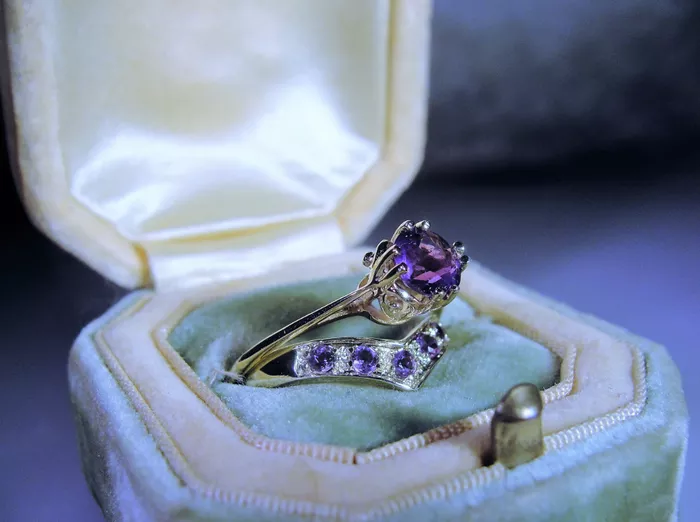Amethyst, with its captivating purple hues, has long been cherished in the world of jewelry. Its allure stems not only from its aesthetic appeal but also from its perceived metaphysical properties and symbolism. However, like all gemstones, amethyst is subject to wear and tear over time. One common concern among jewelry enthusiasts is whether amethyst rings will fade with prolonged wear. In this article, we delve into the factors affecting the durability of amethyst rings and provide practical tips for maintaining their luster.
Understanding Amethyst: Composition and Characteristics
Before addressing the issue of fading, it’s essential to understand the composition and characteristics of amethyst. Amethyst is a variety of quartz, a mineral composed of silicon and oxygen atoms. What distinguishes amethyst from other quartz varieties is its violet to purple coloration, which arises from the presence of iron impurities and irradiation during formation.
Despite its captivating color, amethyst is not among the hardest gemstones. On the Mohs scale of mineral hardness, which ranks minerals from 1 (softest) to 10 (hardest), amethyst scores a moderate 7. This places it in the same range as materials like steel and glass. While amethyst is sufficiently durable for most jewelry applications, it is susceptible to scratches and chips if subjected to rough handling or contact with harder substances.
Factors Affecting Amethyst’s Color Stability
The color stability of amethyst, or any gemstone for that matter, is influenced by various factors, including environmental conditions, exposure to light, and chemical agents. Understanding these factors is crucial for assessing the likelihood of fading in amethyst rings.
Light Exposure: Like many colored gemstones, amethyst can undergo color changes when exposed to prolonged sunlight or artificial light. Over time, ultraviolet (UV) radiation can cause the fading of certain color components in the stone, leading to a loss of vibrancy. However, the extent of color change depends on the specific conditions and the quality of the amethyst.
Chemical Exposure: Amethyst is generally resistant to most household chemicals, but prolonged exposure to harsh chemicals can adversely affect its color and clarity. Substances such as bleach, ammonia, and acidic cleaners should be avoided when cleaning or handling amethyst jewelry, as they can cause damage or discoloration.
Heat Sensitivity: While moderate heat is unlikely to cause significant damage to amethyst, extreme temperature fluctuations can pose a risk. Sudden changes in temperature, such as exposure to high heat or rapid cooling, may cause thermal shock, leading to cracks or fractures in the stone. It’s advisable to remove amethyst rings before engaging in activities that involve exposure to high temperatures, such as hot tubs or saunas.
Physical Abrasion: As mentioned earlier, amethyst ranks 7 on the Mohs scale, making it moderately resistant to scratching. However, it is not impervious to abrasion, especially when in contact with harder materials. To minimize the risk of scratches, amethyst rings should be stored separately from other jewelry pieces and handled with care to avoid impact against hard surfaces.
Tips for Preserving the Color and Integrity of Amethyst Rings
While amethyst rings may exhibit some degree of color change or fading over time, proactive maintenance and proper care can help preserve their beauty and durability for years to come. Here are some practical tips for ensuring the longevity of your amethyst jewelry:
Regular Cleaning: To remove dirt, oils, and other residues that can dull the appearance of amethyst, clean your rings regularly using a mild soap solution and warm water. Gently scrub the surface with a soft brush, such as a toothbrush, and rinse thoroughly before drying with a soft cloth.
See Also: How Much Is a Amethyst Ring Worth?
Avoid Chemical Exposure: As previously mentioned, exposure to harsh chemicals can damage amethyst and accelerate color fading. When cleaning your jewelry or engaging in household chores, remove your amethyst rings and store them in a safe place away from chemical agents.
Store Properly: Proper storage is essential for preventing scratches and minimizing the risk of damage to your amethyst rings. Store them in a fabric-lined jewelry box or pouch, preferably in individual compartments to prevent contact with other jewelry pieces.
Limit Sun Exposure: While it’s perfectly fine to wear your amethyst rings outdoors, avoid prolonged exposure to direct sunlight, especially during peak UV hours. When not wearing them, store your rings in a cool, dark place to minimize the effects of light exposure.
Schedule Professional Inspections: Periodic inspections by a qualified jeweler can help detect any signs of wear or damage early on. A professional jeweler can also provide services such as cleaning, polishing, and re-tightening of gemstones to keep your amethyst rings in optimal condition.
Handle with Care: Treat your amethyst rings with the same care and respect you would afford any valuable piece of jewelry. Avoid exposing them to unnecessary roughness or impact, and remove them before engaging in activities that could pose a risk to their integrity.
Conclusion
In conclusion, while amethyst rings may experience some degree of fading or color change over time, proactive care and maintenance can significantly prolong their lifespan and preserve their beauty. By understanding the factors that influence the durability of amethyst jewelry and following the practical tips outlined in this article, you can enjoy your amethyst rings for years to come, ensuring that their captivating hues continue to sparkle and shine.

